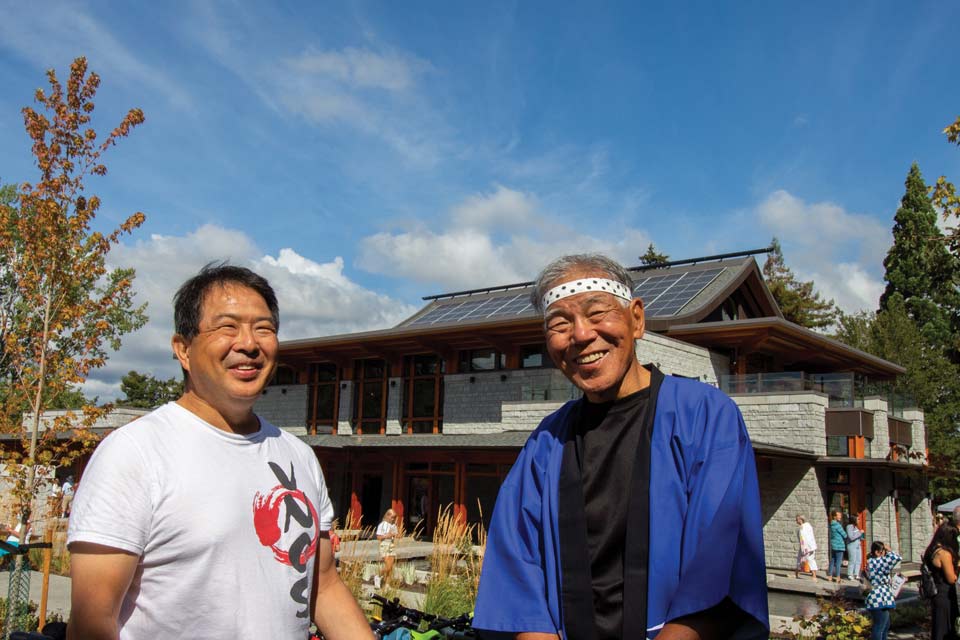Righting a historical wrong
- Jonathan Woods

UVic’s Landscapes of Injustice project documented historical wrongdoings and supported community efforts to build Esquimalt’s new pavilion.
When the doors opened to the newly constructed Gorge Park Pavilion this past June, it offered landmark recognition of the local impacts of discrimination that shattered a community 80 years ago.
In 1942, the Japanese Canadian community on the West Coast was torn apart by the federal government. Over 22,000 Japanese Canadians—the majority Canadian citizens by birth—were deported from a federally defined “protected zone” along BC’s coast and sent to internment camps in the interior of the province and beyond as a purported national security measure.
Among the uprooted were brothers Kensuke and Hayato Takata, owner-operators of a popular Japanese-style tea house and garden—Canada’s first—in what is now Esquimalt’s Gorge Park. The government seized the Takatas’ estate, as with all Japanese Canadians’ property aside from the one or two suitcases they were allowed to take with them on their person to the internment camps. However, under the government’s neglectful custodianship, the property quickly fell victim to looters and vandals, and was left to waste. It wasn’t until 1949, four years after the end of the war, that Japanese Canadians were allowed back to the coast. The Takatas, their livelihood in Victoria ruined, relocated to Toronto to start over.
A legacy of disconnection
Speaking at the grand opening of the new pavilion, Dillon Takata, great-grandson of former tea-house owner Kensuke, related his personal experience as an example of the disruption and trauma that internment and dispossession had on the Japanese Canadian community.
“I grew up, like many Japanese Canadians of my generation, disconnected from the past, cut off from my roots,” Takata recalled. “I carried a Japanese name, but had no knowledge of the culture, spoke not a word of the language. There was a constant internal dissonance. A sense of self that was lacking.”
It took until 1988 for the Canadian government to apologize for the injustices brought upon Japanese Canadians during the war era. Locally, the Township of Esquimalt refurbished and re-opened the Gorge Park Japanese gardens in 2009.
Opportunity for concrete reparation
In 2017, when funds became available for public works in the jurisdiction, the local Japanese Canadian community, led by the Victoria Nikkei Cultural Society (VNCS), came together to field a proposal to build a Japanese tea-house-inspired venue in Gorge Park in honour of the Takatas’ original establishment. The effort was supported by UVic’s Landscapes of Injustice project, a recently-completed, seven-year national project based at the Centre for Asia-Pacific Initiatives that investigated the dispossession of Japanese Canadians during the internment era. The Landscapes team, led by UVic historian Jordan Stanger-Ross and Project Manager Michael Abe, provided the “historical imperative” behind the proposal, uncovering official documentation of the “wanton destruction” of the original tea gardens at the hands of local residents and letters written by the Takatas expressing their pain and frustration upon hearing of the destruction of their home and garden and the sale of their possessions while they were interned in the interior.
The group behind the tea house replacement proposal undertook a public campaign to raise awareness about the importance of rebuilding this erased landmark, writing op-eds, drawing media attention and interviews, meeting with the mayor, attending council meetings, and presenting at local famers’ markets and other establishments. The Landscapes team organized a UVic Ideafest community-oriented event to support the proposal, going so far as to build a rudimentary replica tea house in the MacLaurin Building lobby outside the presentation space for the occasion.
A community facing its past and building its future
Ultimately, after much public consultation, design refinement, and two rounds of voting, township residents selected the adapted tea house proposal as their favoured project. In doing so, they signalled their desire to take a step towards righting a historical wrong in their community. The final design comprises a 6,000 square-foot multi-purpose building and surrounding ponds, abutting the refurbished gardens, and incorporating Japanese architectural features. The main lobby features a historical interpretive wall that tells the story of the original tea house, designed by the Landscapes curatorial team in collaboration with the VNCS, the Takata family, and personnel from the Royal BC Museum and Township of Esquimalt archives.
At the pavilion’s public grand opening on June 18, Dillon’s 96-year-old grandfather, who spent his childhood on the property, came from Ontario to be in attendance. Dillon spoke of his own daughter now attending a Japanese immersion preschool just up the road at the Craigflower schoolhouse, and the importance of places where Japanese Canadians “can come and feel a connection to the past, feel a pride in our heritage,” and repair the cultural disconnect that plagued so many of his own generation. While acknowledging the ongoing work of anti-racism and the Indigenous people who lived in the area for millennia prior to overseas contact, he took the opportunity to celebrate what “feels like the makings of a new community” of Japanese Canadians on the West Coast.
Broken Promises, a museum exhibition created by the Landscapes of Injustice project in partnership with the Nikkei National Museum and the Royal BC Museum, will be on view at the Royal BC Museum until Nov. 13.

